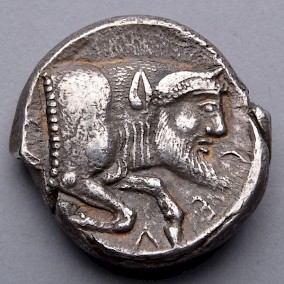Bull of Phalaris
Between 570 and 544, Phalaris was tyrant of Acragas, a newly founded city in southern Sicily, which he made very powerful. Our sources portray him as a clever but cruel man. The most famous story about his cruelty is that of the bull of Phalaris, which is told by the Roman orator Cicero and the historian Diodorus of Sicily (who turns the story upside-down and makes Phalaris a just man, punishing an evil artist).
Cicero, Verrine Orations 4.73
... some things were restored to the Gelans, some to the Acragantines; among which was that noble bull, which that most cruel of all tyrants, Phalaris, is said to have had, into which he was accustomed to put men for punishment, and to put fire under. And when Scipionote restored that bull to the Acragantines, he is reported to have said, that he thought it reasonable for them to consider whether it was more advantageous to the Sicilians to be subject to their own princes, or to be under the dominion of the Roman people, when they had the same thing as a monument of the cruelty of their domestic masters, and of our liberality.
Diodorus of Sicily, World History, 9.19.1
This Phalaris burned to death Perilaus, the well-known Attic worker in bronze, in the brazen bull. Perilaus had fashioned in bronze the contrivance of the bull, making small sounding pipes in the nostrils and fitting a door for an opening in the bull's side and this bull he brings as a present to Phalaris.
And Phalaris welcomes the man with presents and gives orders that the contrivance be dedicated to the gods. Then that worker in bronze opens the side, the evil device of treachery, and says with inhuman savagery, "If you ever wish to punish some man, Phalaris, shut him up within the bull and lay a fire beneath it; by his groanings the bull will be thought to bellow and his cries of pain will give you pleasure as they come through the pipes in the nostrils."
When Phalaris learned of this scheme, he was filled with loathing of the man and says, "Come then, Perilaus, do you be the first to illustrate this; imitate those who will play the pipes and make clear to me the working of your device."
And as soon as Perilaus had crept in, to give an example, so he thought, of the sound of the pipes, Phalaris closes up the bull and heaps fire under it. But in order that the man's death might not pollute the work of bronze, he took him out, when half-dead, and hurled him down the cliffs.
Comment

The story by Cicero was already an old one when he told it. Writing less than a century after Phalaris, the poet Pindar assumes that everybody knows the story of the bull. It was clearly invented to suggest what tyranny was all about, but in spite of its obvious moralism, there may be an element of historical truth.
Human sacrifice was not unknown in Carthage and western Sicily, and it may be noted that in this age, Sicilian rivers were often represented as bulls with human heads. We can no longer reconstruct what really happened, but we cannot exclude the possibility that two stories were conflated - one about human sacrifice in a Carthaginian village near Acragas, and one about a monumental statue dedicated by Phalaris to a river.
One final remark: according to Diodorus, the statue was later brought to Carthage, where the Romans found it after they had captured that city.note